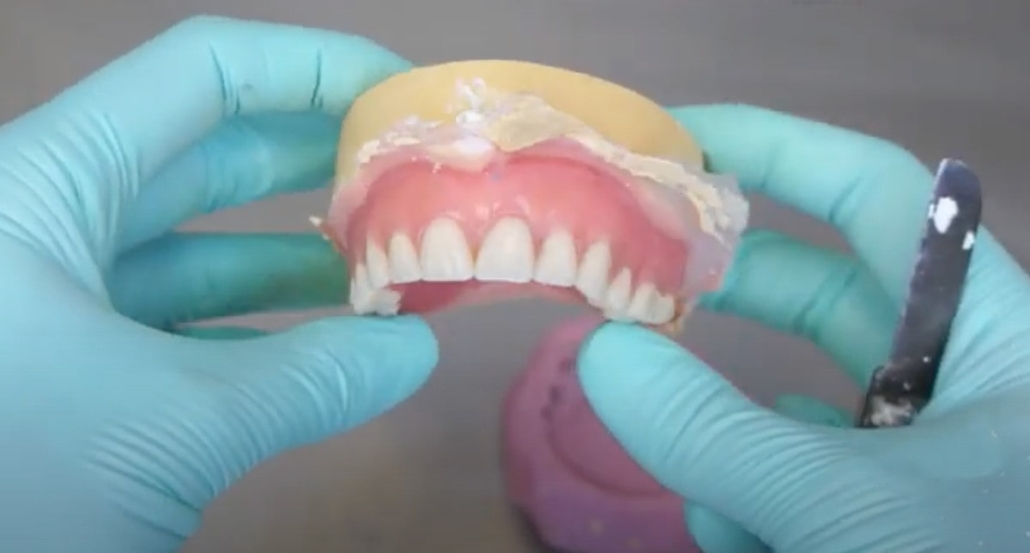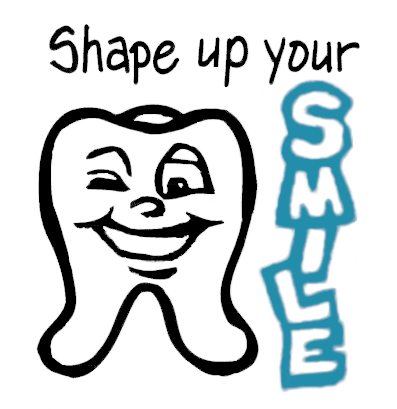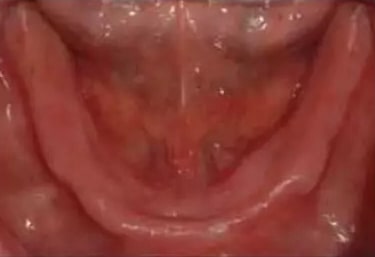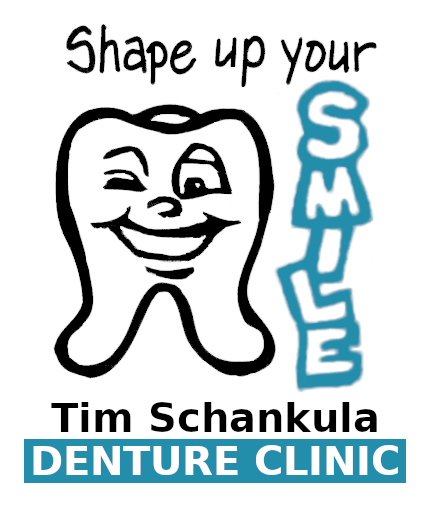 A Reline of your Existing Denture is done when your denture—a Full (complete) Denture or a Partial Denture—has become loose due to gum shrinkage and bone resorption over time. A Reline extends the life of your dentures by ensuring they once again fit well and comfortably—without your needing to constantly resort to adhesive like Poligrip to keep the dentures in your mouth. Unfortunately, in some cases, due to the poor condition of the ridge or saliva content in your mouth, adhesive may still always have to be used.
A Reline of your Existing Denture is done when your denture—a Full (complete) Denture or a Partial Denture—has become loose due to gum shrinkage and bone resorption over time. A Reline extends the life of your dentures by ensuring they once again fit well and comfortably—without your needing to constantly resort to adhesive like Poligrip to keep the dentures in your mouth. Unfortunately, in some cases, due to the poor condition of the ridge or saliva content in your mouth, adhesive may still always have to be used.
If the pink acrylic base of your denture is in too bad a shape to allow a successful Reline (probably because it is too old), but the teeth themselves are still in good-enough shape so you don’t need the fabrication of a New Denture, then you may need a Rebase of your denture instead. A Rebase achieves the same goal as a Reline, except it does so by removing all the pink acrylic base of the denture and makes a new denture base—based on new impressions, again capturing the new shape of your jaw bones, tissues and gums, and thus allowing your denture to fit in your mouth more securely and comfortably.
Problems with Loose Dentures
Problem 1: Loose Denture Are A Nuisance
 No one wishes to experience loose dentures. It makes eating difficult. If your denture is not falling out of your mouth while eating, landing in your food on your plate, or still attached to that apple you just tried to take a bite out of, then it is moving around in your mouth, making it challenging to chew your food and swallow. Often you need to make impossible choices to forgo the food you like or need, just because loose dentures make it impossible to eat them. This can even lead to malnutrition in extreme cases.
No one wishes to experience loose dentures. It makes eating difficult. If your denture is not falling out of your mouth while eating, landing in your food on your plate, or still attached to that apple you just tried to take a bite out of, then it is moving around in your mouth, making it challenging to chew your food and swallow. Often you need to make impossible choices to forgo the food you like or need, just because loose dentures make it impossible to eat them. This can even lead to malnutrition in extreme cases.
Problem 2: More Serious Problems – That Can Be Seen
 In technical terms, loose dentures can be described as an adhesion problem. It’s like gluing two things together with an adhesive: something goes wrong with that adhesive over time, and the two things are no longer stuck together. Denture adhesion may be understood as resistance to the denture separating from the underlying gums and what’s called the alveolar ridges under your gums (collectively, let’s call these the “tissues”). With Full Upper Dentures, it’s a combination of atmospheric pressure outside the base of the denture pressing the denture onto the gums as well as a thin sticky layer of saliva between the base of the denture and the gums that together keep the denture affixed to the tissues; in other words, suction. Scientists long ago discovered that retension (the denture staying affixed to those tissues) “is directly proportional to the covered area by the denture.” What this means is that the more surface area of the denture there is touching those tissues, the greater the retention. With new dentures that are made to fit perfectly, there is 100% surface contact. But gaps forming between those tissues and the denture caused by the tissues changing shape (shrinking) means the denture surface is no longer in direct contact with the tissues in those spots, and the sticky saliva seam is broken. In addition, if the gums have lost their initial elasticity and thickness, retention is dramatically decreased. It’s especially problematic with Full Lower Dentures (as shown in this photo), because there is little to no suction, as well as with patients with small jaws or patients with very flat ridges. As a result, the dentures become loose and move around as you eat and speak, and chronic inflammation of the gums and tissues can take place, which causes significant pain.
In technical terms, loose dentures can be described as an adhesion problem. It’s like gluing two things together with an adhesive: something goes wrong with that adhesive over time, and the two things are no longer stuck together. Denture adhesion may be understood as resistance to the denture separating from the underlying gums and what’s called the alveolar ridges under your gums (collectively, let’s call these the “tissues”). With Full Upper Dentures, it’s a combination of atmospheric pressure outside the base of the denture pressing the denture onto the gums as well as a thin sticky layer of saliva between the base of the denture and the gums that together keep the denture affixed to the tissues; in other words, suction. Scientists long ago discovered that retension (the denture staying affixed to those tissues) “is directly proportional to the covered area by the denture.” What this means is that the more surface area of the denture there is touching those tissues, the greater the retention. With new dentures that are made to fit perfectly, there is 100% surface contact. But gaps forming between those tissues and the denture caused by the tissues changing shape (shrinking) means the denture surface is no longer in direct contact with the tissues in those spots, and the sticky saliva seam is broken. In addition, if the gums have lost their initial elasticity and thickness, retention is dramatically decreased. It’s especially problematic with Full Lower Dentures (as shown in this photo), because there is little to no suction, as well as with patients with small jaws or patients with very flat ridges. As a result, the dentures become loose and move around as you eat and speak, and chronic inflammation of the gums and tissues can take place, which causes significant pain.
Problem 3: More Serious Problems – At the Cellular Level
 What causes the shrinkage of these tissues? There are many reasons for your tissues and bones to shrink over time. But they mostly have to do with either the normal aging process, weight loss or Periodontal Disease—infection of the gums and underlying tissues and bones caused by bacteria.
What causes the shrinkage of these tissues? There are many reasons for your tissues and bones to shrink over time. But they mostly have to do with either the normal aging process, weight loss or Periodontal Disease—infection of the gums and underlying tissues and bones caused by bacteria.
 With natural teeth embedded in these tissues and bones, it is the biting down forces while eating that stimulates this Resorption-Regeneration cycle. If you begin to loose teeth, the tissues and bones under the area where those teeth used to be don’t get those forces to regenerate, so they begin to resorb. It is significantly worse if you’ve lost all your natural teeth, especially on the bottom (as seen in the photo to the left). Implants, which are screwed into your jaw, can slow down that Resorption because they kind of act like teeth roots, so those biting down forces from your Implant Dentures reach the bones to stimulate them. You can read more about this in the “Slows Resorption” part of the Advantages of Implant Dentures section on our FAQ page.
With natural teeth embedded in these tissues and bones, it is the biting down forces while eating that stimulates this Resorption-Regeneration cycle. If you begin to loose teeth, the tissues and bones under the area where those teeth used to be don’t get those forces to regenerate, so they begin to resorb. It is significantly worse if you’ve lost all your natural teeth, especially on the bottom (as seen in the photo to the left). Implants, which are screwed into your jaw, can slow down that Resorption because they kind of act like teeth roots, so those biting down forces from your Implant Dentures reach the bones to stimulate them. You can read more about this in the “Slows Resorption” part of the Advantages of Implant Dentures section on our FAQ page.
Don’t put up with loose dentures any longer than you need to.
Don’t put up with loose dentures
any longer than you need to.
Number of Appointments
An actual Reline of a denture usually requires two appointments, and usually on the same day, one in early- to mid-morning and the second one in late afternoon. If you are also getting a Permanent Soft Liner put into your relined denture, then the second appointment needs to be the next day: the denture needs to stay with us overnight; i.e. the Soft Liner process takes longer. (If it’s a Rebase that is needed, it also requires two appointments, but the second appointment also needs to be the next day: the denture needs to stay with us overnight; i.e. a Rebase process takes longer.)
Relines
(1-2 appointments over 1-2 days usually)
Permanent Reline (2 appointments, usually on the same day):
If you wish to get your denture back the same day, and not leave it at the clinic overnight, then your first appointment needs to be early- to mid-morning, and the second appointment will be later that same day in late afternoon:
Temporary Liner (usually same day, 1 appointment)
A Temporary Liner (a.k.a. tissue conditioner or temporary reline), is usually placed into an Immediate Denture when it gets too loose to wear, as the swelling in your gums goes down and your gums shrink. The procedure can also be done as a temporary measure for other types of dentures that have become loose due to gum resorption (shrinkage). The procedure can usually be done on the same day you call to book the appointment in an available spot on our schedule, or the next business day if you call after hours, and you only need that single appointment:
Your denturist will usually be able to insert the temporary liner into your denture in the on-site lab while you wait in the dental chair.










